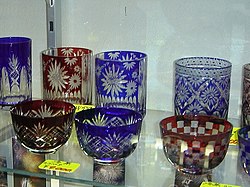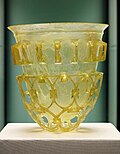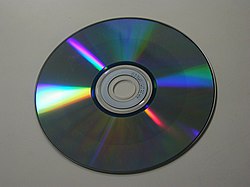Glass
Glass is a hard material that can be made in many shapes. It is usually transparent, but it can also be made in colours. Glass is mainly made of silica; glass made of silica only is called silica glass.
Glass used to make windows and bottles is a specific type called soda-lime glass, composed of about 75% silicon dioxide (SiO2), sodium oxide (Na2O) from sodium carbonate (Na2CO3), calcium oxide, also called lime (CaO), and several minor additives.
By changing the proportions, and adding different ingredients, many kinds of glass can be made. Coloured glass is made by adding small amounts of metal oxides. For example, a blue colour is given by tiny amounts of cobalt oxide.
Crystal glass is made by adding lead and zinc oxides. It is not actually a crystal because all glass is a non-crystalline solid. Crystal glass is called cut glass if it has been cut by hand:
- " 'Cut glass' is glass that has been decorated entirely by hand by use of rotating wheels. Cuts are made in an otherwise completely smooth surface of the glass by workers holding and moving the piece against various sized metal or stone wheels".[1]
Because glass is used to make lenses, the word "glasses" often means eyeglasses.
The myth that glass is actually a liquid comes from the fact that old windows in houses and churches (200–300 years old) are sometimes a little out of shape: thicker at the bottom than the top. This is actually due to the process of glass making in the past which led to the glass pane being thicker at one edge than the other. It was sensible to install the windows with the thick edge at the bottom. Sometimes a window can be found with the thick edge at the top of the window.
Glass can be recycled over and over. Glass bottles and jars can easily be recycled to make new glass bottles and jars or used in industry as aggregate (building material) or sand.
Glass Media
The amorphous structure of glassy silica (SiO2) in two dimensions. No long-range order is present, although there is local ordering to the tetrahedral arrangement of oxygen (O) atoms around the silicon (Si) atoms.
Microscopically, a single crystal has atoms in a near-perfect periodic arrangement; a polycrystal is composed of many microscopic crystals; and an amorphous solid such as glass has no periodic arrangement even microscopically.
Windows in the choir of the Basilica of Saint-Denis, one of the earliest uses of extensive areas of glass (early 13th-century architecture with restored glass of the 19th century)
Quartz sand (silica) is the main raw material in commercial glass production
A high-strength glass-ceramic cooktop with negligible thermal expansion
A CD-RW (CD). Chalcogenide glass forms the basis of rewritable CD and DVD solid-state memory technology.
References
Other websites
| Wikimedia Commons has media related to Lua error in Module:Commons_link at line 62: attempt to index field 'wikibase' (a nil value).. |
- Corning Museum of Glass
- A comprehensive guide to art glass and crystal around the world Archived 2010-12-26 at the Wayback Machine
- Working Description Furnace & Moleria - Murano Glass
- Informative website about the glass industry
- Substances used in the Making of Colored Glass Archived 2005-11-30 at the Wayback Machine
- Almost 400 articles and images about glass (mostly art glass)













